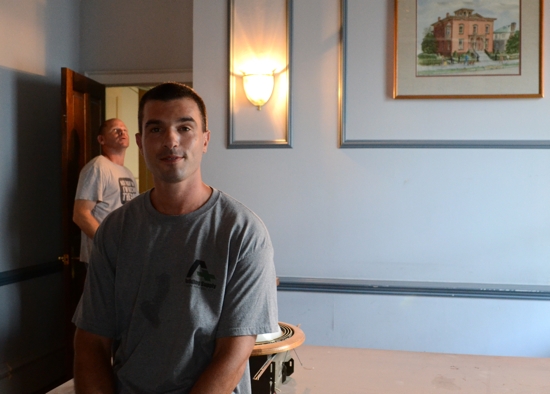
Melissa Bailey Photo
Samuel Merwin’s ghost will soon have a new room to sleep in.
That’s because a plan to convert an Orange Street mansion back into housing passed unanimously at the City Plan Commission meeting last week.
Samuel Merwin, a former Civil War general and lieutenant governor, built the mansion at 412 Orange St. in 1869 during the economic boom that followed the war. After Merwin lived there, the home became a school and eventually a methadone clinic, before attorney and former Alderman Jon Einhorn turned it into law offices in the1980s.

Melissa Bailey Photo
Einhorn sold the house this year for $750,000. New owners Gil Marshak and Oren Bitman are now investing several hundred thousand more into turning it into five condominiums.
Plans calls for two condos using a combined basement and first floor; two condos on the second floor, and one condo on the third floor, which includes a charming domed cupola.
City Plan Commission Chair Ed Mattison said he is delighted with the plan: “It’s such a wonderful building.”

Melissa Bailey Photo
Marshak (foreground) and Bitman with a painting of the home.
Marshak and Bitman plan not to change any of the exterior of the long-windowed Italianate building that sits on the west side of Orange two lots south of Trumbull Street. Except for a new roof, replacement windows and a handicapped lift in the rear, the building will remain essentially the same.
This is a departure for Marshak and Bitman, who have specialized in purchase and renovation of more modest properties, primarily in Fair Haven.
Marshak said he is talking to the fire marshal about trying to keep the original front doors and stoop. Although 412 does not sit in any local historic district, the city’s historic resources inventory lists it as a contributing structure in the Orange Street national Register Historic District, according to a report from City Plan staff.
That means the developers are eligible to apply for tax credits based on the structure’s historic significance. The City Plan report encourages the builders to maintain the exterior including the metal rail along the front yard.
Some local historians, such as Channing Harris with the New Haven Preservation Trust, have speculated that the fad for iron railings post-Civil War in New Haven came about because local factories had geared up to manufacture cannon balls. Then the Civil War came to an end more abrupt than expected. What to do with all that iron-making capacity?
“We’re trying to maintain the features that give it character,” Marshak said.